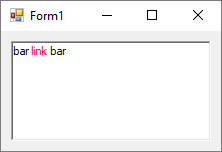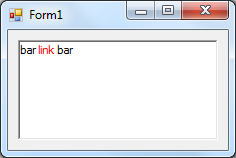For Windows 8 and above, you can use the SendMessage function to send the EM_SETEDITSTYLEEX message to richedit control to disable the underlining of friendly links by specifying SES_EX_HANDLEFRIENDLYURL for the lParam argument and zero for the wParam` argument.
SES_EX_HANDLEFRIENDLYURL
Display friendly name links with the same text color and underlining as automatic links, provided that temporary formatting isn’t used or uses text autocolor (default: 0).
Even though the underlining is supposedly disabled by default, the RichTextBox control has it enabled.
Add the following to your ExRichText class to provide a method (UnderlineFriendlyLink) to disable the underlining.
private const Int32 WM_User = 0x400;
private const Int32 EM_SETEDITSTYLEEX = WM_User + 275;
private const Int32 EM_GETEDITSTYLEEX = WM_User + 276;
/// <summary>Display friendly name links with the same text color and underlining as automatic links, provided that temporary formatting isn’t used or uses text autocolor (default: 0)</summary>
private const Int32 SES_EX_HANDLEFRIENDLYURL = 0x100;
[DllImport("user32.dll", CharSet = CharSet.Auto)]
private extern static Int32 SendMessage(HandleRef hWnd, Int32 msg, Int32 wParam, Int32 lParam);
public static void UnderlineFriendlyLink(RichTextBox rtb, bool enabled = false)
{
if (rtb.IsHandleCreated)
{
Int32 wParam = enabled ? SES_EX_HANDLEFRIENDLYURL : 0;
Int32 lParam = SES_EX_HANDLEFRIENDLYURL; // settings mask
Int32 res = SendMessage(new HandleRef(null, rtb.Handle), EM_SETEDITSTYLEEX, wParam, lParam);
}
}
Example usage:
public partial class Form1 : Form
{
public Form1()
{
InitializeComponent();
}
private void Form1_Load(object sender, EventArgs e)
{
exRichText1.Rtf = @"{\rtf1\ansi\ansicpg1252\deff0\nouicompat\deflang1033{\fonttbl{\f0\fnil\fcharset0 Microsoft Sans Serif;}}{\colortbl ;\red0\green0\blue255;}{\*\generator Riched20 10.0.16299}\viewkind4\uc1 \pard\f0\fs29 Hello {\b{\field{\*\fldinst{HYPERLINK ""http://www.fred.com""}}{\fldrslt{Link}}}}\f0\fs29\par\par https://www.google.com \par\par sd {{\field{\*\fldinst{HYPERLINK ""http://www.fred.com""}}{\fldrslt{klasl}}}}\f0\fs29 wed asdasd \par\par}";
}
private void exRichText1_LinkClicked(object sender, LinkClickedEventArgs e)
{
System.Diagnostics.Debug.Print(e.LinkText);
}
private void button1_Click(object sender, EventArgs e)
{
ExRichText.UnderlineFriendlyLink(exRichText1, false);
}
}
Your post did not indicate how you are detecting the clicking of the links, but be advised that if you are relying on the LinkClicked event as shown in the above example that event may not fire due to a logic bug in the RichTextBox CharRangeToString method. In particular this code fragment.
//Windows bug: 64-bit windows returns a bad range for us. VSWhidbey 504502.
//Putting in a hack to avoid an unhandled exception.
if (c.cpMax > Text.Length || c.cpMax-c.cpMin <= 0) {
return string.Empty;
}
If you try the sample code, you will notice that the event fires only for the first link. If CharRangeToString returns String.Empty, the event is not raised. This limiting condition uses the Text.Length property (58 for the example) that returns the as displayed length. I believe that it should instead use the TextLength property (120 for the example).
By monitoring the control's parent for the EM_Notify message and processing the mouse click notification, it is possible to extract the link using the CharRange structure when compiling for x86 or AnyCPU(prefer 32-bit). When running as a 64-bit assembly, the CharRange structure does return invalid values as indicated in the source code.
Edit: All testing was done on Windows 10 version 1706 as I will not install 1803 at this time.



